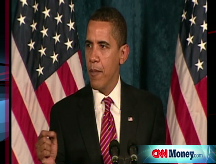Big rally on Wall Street
Wall Street breaks its four-week losing streak on optimism about the government's stimulus package and bank bailout plan.
NEW YORK (CNNMoney.com) -- Bank and housing shares led a broad rally Friday as optimism about the government's economic stimulus bill and the new version of the bank bailout plan countered unease following the brutal January jobs report.
The Dow Jones industrial average (INDU) added 217 points, or 2.7%. The Standard & Poor's 500 (SPX) index added 23 points, or 2.7%.
The Nasdaq composite (COMP) added 45 points, or 2.9%, and closed at a one-month high.
All three major gauges ended higher for the week as well, ending a four-session losing streak.
"I think we're rallying today in anticipation of the stimulus package," said Len Blum, managing director at Westwood Capital.
If anything, the poor January jobs report - which showed a loss of nearly 600,000 jobs - added to the optimism about the stimulus package, by inciting a sense of urgency in lawmakers and investors.
Blum said that investors were relieved that although the employment report was bad, it wasn't as bad as some had been fearing.
"Yet it's still bad enough that it gives Senate Democrats some ability to push for the legislation to go through quickly," he said. "It puts the heat on Congress to move fast."
The Senate is working Friday to cut down a more than $900 billion package after a different version of the plan, then valued at $819 billion, won party-line approval in the House last week. Senate Majority Leader Harry Reid, D-Nev., said a vote could happen Friday evening.
Banking shares rallied for the second session as investors looked to Monday's announcement on how the government will use the remaining $350 billion of the Treasury's Troubled Asset Relief Program (TARP).
Bank stocks led the advance, including Dow components Citigroup (C, Fortune 500), American Express (AXP, Fortune 500) and JPMorgan Chase (JPM, Fortune 500). Bank of America (BAC, Fortune 500) jumped 26% after falling to a more than 20-year low Thursday.
Stocks gained Thursday on hopes about the bank bailout plan and better-than-expected monthly sales from Wal-Mart Stores. Throughout the week, investors have taken a measured response to news that has been bad, but not as bad as expected, including reports on manufacturing and housing. That optimism was sustained Friday.
Market breadth was positive. On the New York Stock Exchange, winners beat losers almost five to one on volume of 1.61 billion shares. On the Nasdaq, advancers topped decliners three to one on volume of 2.45 billion shares.
Financials: Treasury Secretary Tim Geithner is expected to speak Monday about how the government plans to use the rest of the TARP money.
Plans in discussion include the creation of a so-called "bad bank" that would let the government take bad assets off bank balance sheets, which would purportedly get banks to start lending again.
Reports also say the government could temporarily suspend or alter the "mark-to-market" accounting rule, which would mean the government could buy the assets at a price that is below market rate, but not at fire sale prices.
Among the criticisms of the way the Bush administration handled the first half of the TARP is that the Treasury overpaid for the bad assets it bought. Changing the mark-to-market rule might address that particular critique.
Job losses: Employers cut 598,000 jobs in January, as the recession continued to ravage corporate profits and spark massive layoffs. It was the worst month of job losses in 34 years, surpassing the 540,000 job cuts economists were expecting, according to a Briefing.com survey.
The unemployment rate, generated by a separate survey, rose to 7.6% from 7.2% the previous month, topping forecasts for a rise to 7.5%. The unemployment rate is at its highest since September 1992.
The report also showed that 2.6 million people have been out of work for at least six months, the largest number of long-term unemployed since 1983. (Full story)
"The report makes it clear that we are losing jobs at an alarming pace and we need a stimulus package as fast as possible," said Scott Anderson, senior economist at Wells Fargo.
He said that he does not agree with the stock and bond markets' measured response.
"I'm not as optimistic as the markets are," he said. "I think unemployment will hit 9% by the end of the year and will peak above 9% sometime in the first quarter of 2010."
Bonds: Treasury prices slumped, raising the yield on the benchmark 10-year note to 2.98% from 2.89% Thursday. Treasury prices and yields move in opposite directions.
Lending rates were mixed. The 3-month Libor rate held steady at 1.24%, unchanged from Thursday, according to Bloomberg.com. The overnight Libor rate slipped to 0.31% from 0.32% Thursday. Libor is a bank lending rate.
Other markets: In global trading, Asian and European markets rallied.
The dollar was mixed, falling against the euro and rising against the yen.
U.S. light crude oil for March delivery fell $1 to settle at $40.17 a barrel on the New York Mercantile Exchange.
COMEX gold for April delivery rose 10 cents to settle at $914.30 an ounce.
Gasoline prices rose three-tenths of a cent to a national average of $1.91 a gallon, according to a survey of credit-card swipes released Friday by motorist group AAA. ![]()




